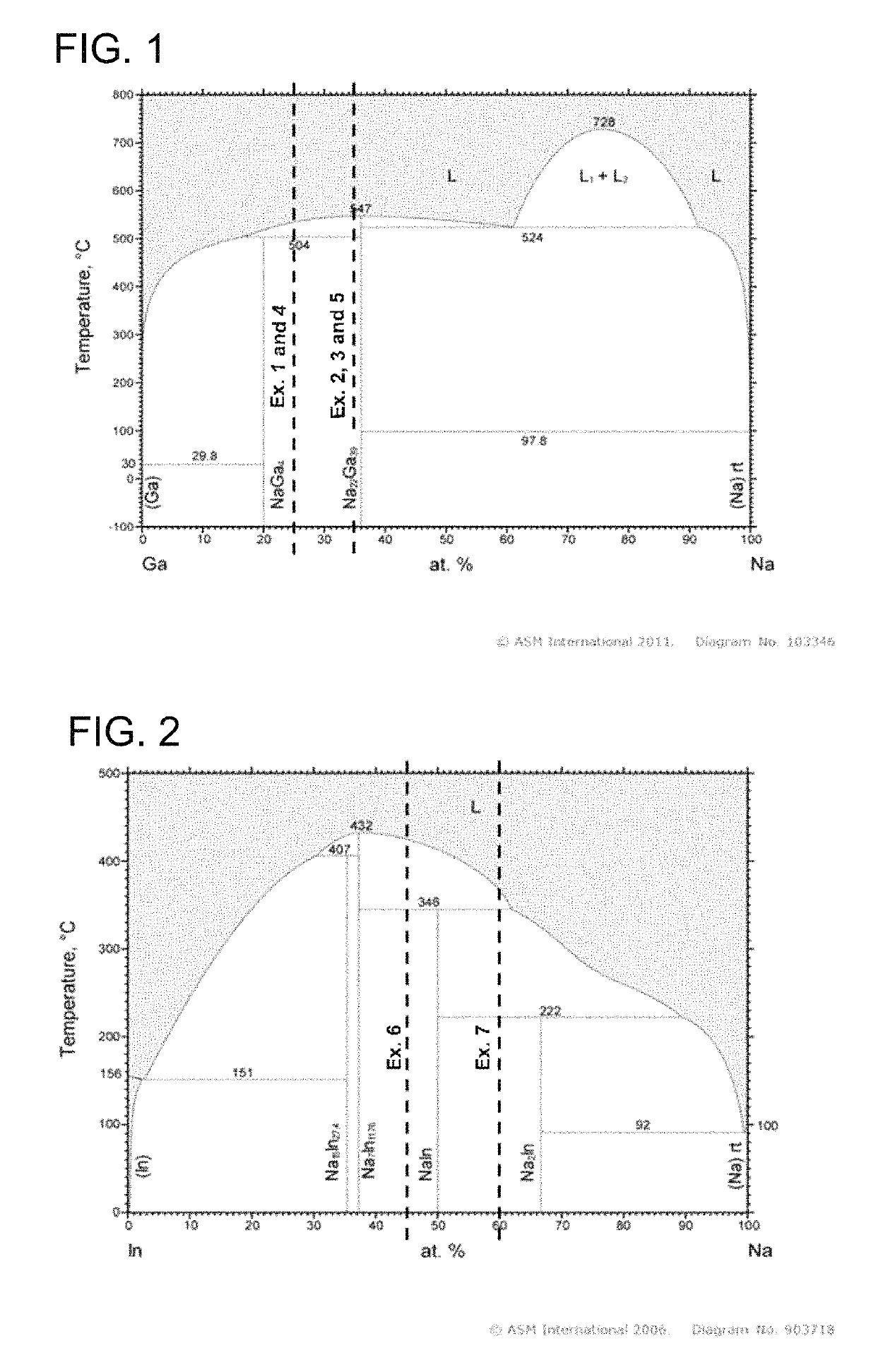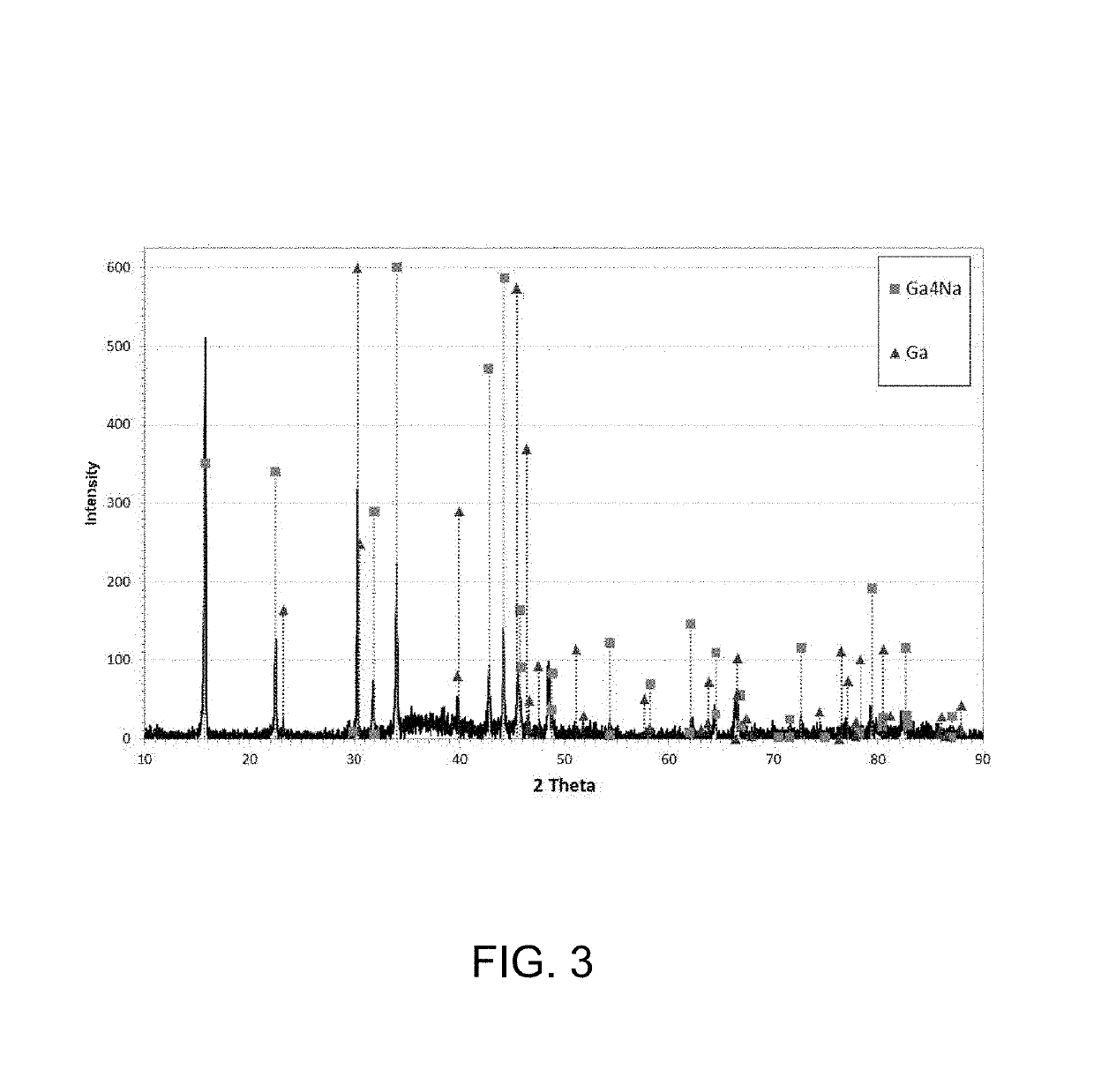Cu—Ga—In—Na target
a target and cu-ga technology, applied in the field of sputtering targets, can solve the problems of reducing the homogeneity of the microstructure and the density of the target, reducing the quality of the deposited layer, and reducing the sputtering process. , to achieve the effect of good processability, high purity and low cos
- Summary
- Abstract
- Description
- Claims
- Application Information
AI Technical Summary
Benefits of technology
Problems solved by technology
Method used
Image
Examples
example 1
[0061]1 kg of Ga were heated to 200° C. and melted in a graphite crucible by means of induction heating. Subsequently, 0.1 kg of Na was added (ratio in at % Ga / Na=75 / 25). The temperature was subsequently increased to 600° C. After complete melting, the alloy was cast in a die made from hot-work steel.
[0062]After solidification, the ingot thus produced was removed and, after complete cooling, comminuted with the aid of a jaw crusher and a cross-beater mill.
[0063]Thereafter, the Ga—Na preliminary alloy powder thus obtained was screened off to a size of <500 μm and mixed with gas-atomized Cu—Ga alloy powder (Ga content 25 at %), such that an Na content of 1 at % was established.
[0064]The Cu—Ga—Na powder mixture thus obtained was compacted to a disc in a uniaxial hot press at a temperature of 400° C. and then processed to completion to give a sputtering target having a thickness of 5 mm and a diameter of 100 mm.
example 2
[0065]5 kg of Ga were heated to 200° C. and melted in a graphite crucible by means of induction heating. Subsequently, 0.9 kg of Na was added (ratio in at % Ga / Na=65 / 35). The temperature was subsequently increased to 600° C. After complete melting, the alloy was cast in a die made from hot-work steel.
[0066]After solidification, the ingot thus produced was removed and, after complete cooling, comminuted with the aid of a jaw crusher and a cross-beater mill.
[0067]Thereafter, the Ga—Na preliminary alloy powder thus obtained was screened off to a size of <500 μm and mixed with gas-atomized Cu—Ga alloy powder (Ga content 25 at %), such that an Na content of Sat % was established.
[0068]The Cu—Ga—Na powder mixture thus obtained was introduced into a tubular steel capsule, hot-degassed at 300° C. and sealed airtight. The powder was compacted by means of hot isostatic pressing at a temperature of 450° C., a pressure of 100 MPa.
[0069]The blank thus obtained was subsequently processed by means...
example 3
[0070]5 kg of Ga were heated to 200° C. in an Ar protective gas atmosphere and melted in a graphite crucible by means of induction heating. Subsequently, 0.9 kg of Na was added (ratio in at % Ga / Na=65 / 35). In the course of this, the temperature was increased to 600° C. After the alloy had melted completely, atomization was effected by means of Ar gas to a spherical preliminary alloy powder.
[0071]Subsequently, the preliminary alloy powder thus obtained was mixed with likewise gas-atomized Cu—Ga alloy powder (Ga content 30 at %) to give a Cu—Ga—Na powder mixture having an Na content of 1 at %.
[0072]The Cu—Ga—Na powder mixture thus obtained was compacted in a uniaxial hot press by means of spark plasma sintering (SPS) at a temperature of 400° C. to give a disc, and then processed to completion to give a disc-shaped sputtering target having a thickness of 5 mm and a diameter of 100 mm.
PUM
| Property | Measurement | Unit |
|---|---|---|
| melting points | aaaaa | aaaaa |
| aspect ratio | aaaaa | aaaaa |
| size | aaaaa | aaaaa |
Abstract
Description
Claims
Application Information
 Login to View More
Login to View More - R&D
- Intellectual Property
- Life Sciences
- Materials
- Tech Scout
- Unparalleled Data Quality
- Higher Quality Content
- 60% Fewer Hallucinations
Browse by: Latest US Patents, China's latest patents, Technical Efficacy Thesaurus, Application Domain, Technology Topic, Popular Technical Reports.
© 2025 PatSnap. All rights reserved.Legal|Privacy policy|Modern Slavery Act Transparency Statement|Sitemap|About US| Contact US: help@patsnap.com


